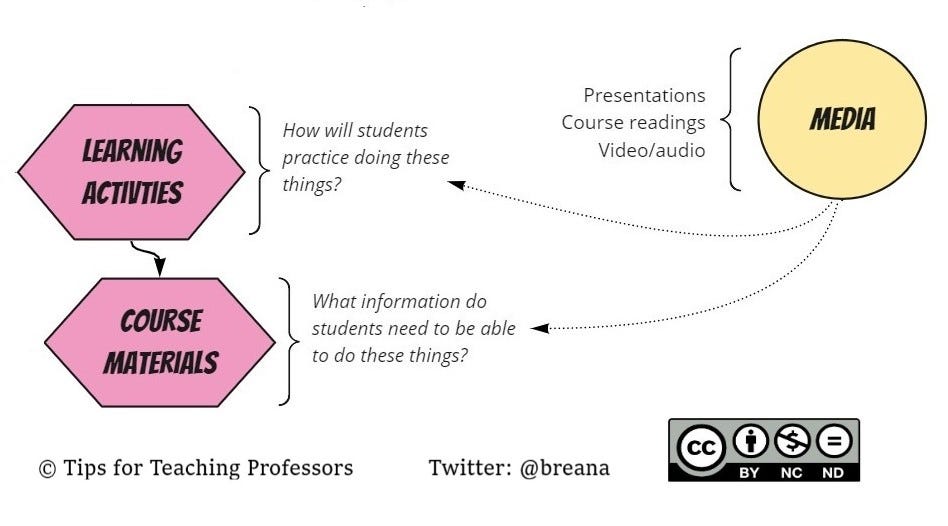Tip: Learning Activities & Course Materials
Thinking about how to offer students opportunities explore and practice course skills and content.
This summer course design series started with an overview here and continued with thinking about learning outcomes and assessments. After considering how you will know whether students have mastered the skills and content is where the real fun comes in: planning the learning activities and course materials that provide opportunities to explore the skills and content, to practice the skills, to connect content knowledge to what they have learned in prior courses, and prepare to transfer skills and knowledge to new contexts. The key questions I think about are:
How will students practice the skills?
This question asks us to think about what activities we can prepare for students that will introduce content knowledge, help them to build connections between prior knowledge and new knowledge, and use their growing understandings in new (to them) ways. It focuses on the skills, the procedural knowledge, more than the content knowledge (although certainly each type of knowledge is dependent on the other, as you can’t do things without knowing things, and knowing things is not very helpful without knowing what to do with what you know).
What information do students need to be able to practice the skills?
In order for students to do something - code a program, conduct a lab experiment, write an outline - there’s content they need first. They can’t write up the lab procedures without knowing what to call the equipment, and they can’t write an outline without understanding the role that supporting sentences play.
To continue with the example from last week, students have the following goal:
Students will be able to contrast two different places they have lived, addressing physical space, geographical location, and family connections.
And the following assignment expectations:
Uses contrast language effectively so the purpose of the work is clear to the reader
Addresses physical space, geographical location, and family connections
Uses supporting evidence (anecdote, quotation, description, etc.) to support the main points
Work follows appropriate formatting and presentation requirements*
Each of those assignment expectations provides rich space for exploring students’ existing content and procedural knowledge, and building on that foundation. We could begin with uses contrast language effectively and think about how to introduce students to the targeted language structures through reading and analysis of example texts. Of course, the focus on contrast language wouldn’t happen in isolation; as we read the example text we would notice many different things happening, discussing what made certain choices more or less effective. Once students identified some of the vocabulary and grammatical structures, we would put them into practice, using new content knowledge to practice procedural knowlege.
To be able to carry out these planned learning activities, I need to find - or create - supporting course materials. At a minimum I need an example text, some guiding questions, maybe some supplemental materials for explicit instruction. If this were a new course, or I were a new instructor, I would want to err on the side of having more materials prepared. Two or three models to examine, a more structured presentation in case I’ve misjudged how much noticing on their own students can do and how much explicit instruction I need to provide, perhaps some more guided practice opportunities. What you need to create is going to be very different depending on the class and level, but also depending on your teaching style and the learners you have. If you’ve taught the same course several semesters in a row, you’ve had the opportunity to collect enough plan A and plan B and perhaps plan C materials.
What comes next?
After planning out the outcomes, assessments, learning activities, and materials…it is time to think about how these components contribute to the overall course structure. How will you pace the learning activities? How will you fit in formative assessments that are helpful and meaningful for students? What should students do on their own, prior to class, and what happens in class? What is small group work versus whole group work? These questions, and more, are what will guide the building phase next week.
Please join me in supporting the Northern Virginia Community College’s Emergency Student Aid fund. Newsletter subscriptions will go towards a goal of donating $1000 by the end of the summer to the fund.



